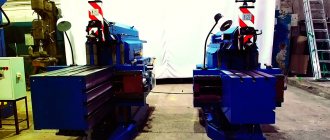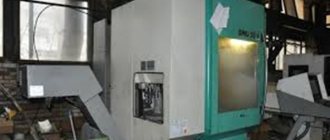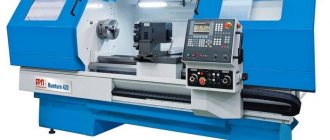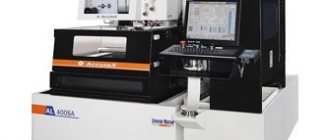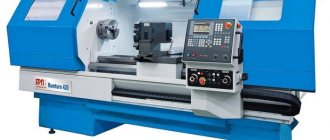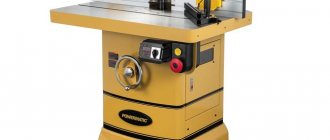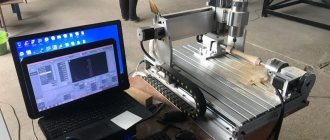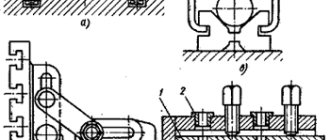Metal planing machines are designed for roughing and finishing processing of workpieces of various shapes. Thanks to the ability to replace cutters, you can achieve the desired processing speed, cut various metals, and obtain the required level of productivity. Used in industry, workshops, repair shops.
Cross-planing machine (Photo: Instagram / kubanzheldormash)
Specifications
Technical characteristics of planing machines:
- working surface size - from 200x180 mm to 1500x6000 mm;
- maximum height of the processed workpiece - up to 1.23 m;
- the maximum distance between the working surface and the crossbar is 1.25 m;
- permissible weight of parts - up to 8 tons;
- electric motor power, depending on the machine model - from 500 W to 150 kW;
- the maximum angle of rotation of the incisors in both directions is 600;
- processing speed - from 3 to 60 m/min.
Power consumption
Basic models have a power consumption of about 1200 watts. This type of machine will be used for planing small pieces of wood and is more suitable for soft wood.
- If you want to use the power of the combination machine, please note the power consumption from 1500W.
- To give you a better idea, semi-pro and professional machines start at 2000 watts.
- Don't forget to check the thicknesser's power supply to see if it can be plugged into a standard 230V outlet.
Design and principle of operation
The mechanical part of planing machines consists of the following elements:
- cast iron or steel frame - the main part of the structure that bears the main loads, used to accommodate the assembly with the cutting tool and the work table;
- working surface - designed for placing workpieces and fastening them;
- guides—necessary for moving the slider or working surface;
- slider - performs translational movements when processing workpieces;
- a cutter used for cutting metal;
- caliper - fixes the cutter at a certain angle;
- gearbox - used to change the rotation speed of the spindle with a fixed workpiece;
- vice for fixing parts during processing.
The design also includes electrical components: motor, controls, monitoring sensors, protection systems. To cool the mechanical elements, a system for supplying lubricants and coolants is used. All machine components are located inside a steel or cast iron body.
The operating principle is based on direct contact of the cutting tool with the workpiece. Machining occurs when the workpiece moves or rotates relative to the cutter.
Processing the part (Photo: Instagram / khuevgen)
Electrical equipment, light, lighting
Many people prefer to do small carpentry work at home or in the countryside. This allows you to give free rein to your imagination and save money from the family budget. But to work with wood, you need available tools, for example, a planer, which you can make yourself.
The emergence of the planer
The first planing machine has been known since the time of Leonardo Da Vinci. But it did not influence the development of this equipment, since all records were lost. The scientist de la Hire from France in 1719 designed a planing machine, which was originally a modification of a lathe, and the movement was carried out by a rope from the beam.
And today there are many different planing machines, which, depending on the work performed, are divided into the following groups: general purpose machines, specialized and special machines.
General purpose machines include longitudinal planing and cross planing. Special machines are designed to perform specific detailed operations and are mainly used in mass production.
Specialized machines include cross-planing machines with a movable carriage for working with heavy parts, pit longitudinal planing machines for processing heavy and large parts, and edge-planing equipment for processing the edges of large sheets.
The longitudinal planing machine is designed for processing large workpieces. Such devices come in single- and double-column types. In the process of cutting metal on a longitudinal planing machine, movements are transferred to the workpiece, which is previously fixed on the table of the planing machine. Its main characteristics are the width and length of the planing. The maximum length reaches up to 25, and the width reaches 5 meters.
A cross-planing machine is used to work with medium or small workpieces. The movements are transmitted to the cutting tool, and not to the workpiece. This tool is placed on a slide. A characteristic of such a planing machine is the stroke length of the slide, which reaches 2.5 meters. You can move the table where the workpiece is fixed in horizontal and vertical planes.
Purpose of planing machines
Planing machines are necessary for processing ruled surfaces - vertical, horizontal and inclined planes. Ruled surfaces also include shaped surfaces, which are a combination of planes located at different angles.
With the help of metalworking and woodworking planing machines, it is also possible to process shaped surfaces, the profile of which has curved sections that are formed by circular arcs or complex curves. Planing machines process not only flat surfaces, but also grooves, straight grooves, ledges and various recesses. It is possible to process metal in a closed loop.
Small-sized parts and large forgings, welded structures and castings that have a length of up to 12 meters, a width of up to 6 meters and a height of up to 3 meters are processed using a planing machine. The weight of such parts can reach up to 200 tons.
On planing machines, the workpiece is processed along a plane, thickness or angle, thanks to which the lumber acquires ideal evenness. On a double-sided jointing machine, the layer and the edge of the part are simultaneously processed. Parallel planes are processed using double-sided thicknessing equipment.
Metal-cutting machines of a planing nature are used in special machine shops for processing all kinds of parts in the automotive industry. They are also found in many repair shops and tool shops. They are well suited for working with parts made of steel, various non-ferrous alloys and even some types of plastic.
Wood planing machines are used to process the surface of wood after sawing “clean”, making lumber and parquet. They are designed for processing straight workpieces and plane milling. Using different sets of knives allows you to work with soft (spruce, pine) and hard (poplar, oak, beech) wood species.
Types of metal planing machines
Classification of metal planing machines according to processing technology:
- For longitudinal planing. The table with the part moves relative to the cutter.
- For cross planing. The cutting part moves above the work table on which the part is fixed.
By type of drive:
- hydraulic - moving mechanisms move or rotate at a constant speed;
- crank-crank - the units move in accordance with the settings of the rocker mechanism, that is, the speed can be selected for a specific processing technology.
According to the method of influencing the workpiece:
- lingering - used to remove surface layers (horizontal, vertical or a combination of the first two options)
- shaped-planing - designed to create complex curved surfaces;
- slotting - used to create holes and grooves when moving the cutting tool exclusively along the vertical axis.
Electrical equipment, light, lighting
Many people prefer to do small carpentry work at home or in the countryside. This allows you to give free rein to your imagination and save money from the family budget. But to work with wood, you need available tools, for example, a planer, which you can make yourself.
The emergence of the planer
The first planing machine has been known since the time of Leonardo Da Vinci. But it did not influence the development of this equipment, since all records were lost. The scientist de la Hire from France in 1719 designed a planing machine, which was originally a modification of a lathe, and the movement was carried out by a rope from the beam.
And today there are many different planing machines, which, depending on the work performed, are divided into the following groups: general purpose machines, specialized and special machines.
General purpose machines include longitudinal planing and cross planing. Special machines are designed to perform specific detailed operations and are mainly used in mass production.
Specialized machines include cross-planing machines with a movable carriage for working with heavy parts, pit longitudinal planing machines for processing heavy and large parts, and edge-planing equipment for processing the edges of large sheets.
The longitudinal planing machine is designed for processing large workpieces. Such devices come in single- and double-column types. In the process of cutting metal on a longitudinal planing machine, movements are transferred to the workpiece, which is previously fixed on the table of the planing machine. Its main characteristics are the width and length of the planing. The maximum length reaches up to 25, and the width reaches 5 meters.
A cross-planing machine is used to work with medium or small workpieces. The movements are transmitted to the cutting tool, and not to the workpiece. This tool is placed on a slide. A characteristic of such a planing machine is the stroke length of the slide, which reaches 2.5 meters. You can move the table where the workpiece is fixed in horizontal and vertical planes.
Purpose of planing machines
Planing machines are necessary for processing ruled surfaces - vertical, horizontal and inclined planes. Ruled surfaces also include shaped surfaces, which are a combination of planes located at different angles.
With the help of metalworking and woodworking planing machines, it is also possible to process shaped surfaces, the profile of which has curved sections that are formed by circular arcs or complex curves. Planing machines process not only flat surfaces, but also grooves, straight grooves, ledges and various recesses. It is possible to process metal in a closed loop.
Small-sized parts and large forgings, welded structures and castings that have a length of up to 12 meters, a width of up to 6 meters and a height of up to 3 meters are processed using a planing machine. The weight of such parts can reach up to 200 tons.
On planing machines, the workpiece is processed along a plane, thickness or angle, thanks to which the lumber acquires ideal evenness. On a double-sided jointing machine, the layer and the edge of the part are simultaneously processed. Parallel planes are processed using double-sided thicknessing equipment.
Metal-cutting machines of a planing nature are used in special machine shops for processing all kinds of parts in the automotive industry. They are also found in many repair shops and tool shops. They are well suited for working with parts made of steel, various non-ferrous alloys and even some types of plastic.
Wood planing machines are used to process the surface of wood after sawing “clean”, making lumber and parquet. They are designed for processing straight workpieces and plane milling. Using different sets of knives allows you to work with soft (spruce, pine) and hard (poplar, oak, beech) wood species.
How to choose a planing machine
Criterias of choice:
- desktop area;
- installed engine power;
- speed of movement of the cutter relative to the workpiece;
- available cutting methods;
- table configuration;
- possibility of positioning the cutter: angle of inclination, trajectory of movement;
- degree of protection of the housing from dust and moisture;
- maximum permissible weight of processed parts;
- manufacturer, warranty period, availability of additional options to expand functionality.
Equipment configuration (Photo: Instagram / kubanzheldormash)
Advantages and disadvantages
Advantages of planing machines:
- versatility of application - processing of various types of metals;
- selection of optimal cutting speed;
- wide selection of cutting tools;
- the possibility of roughing or finishing to obtain the desired level of surface roughness;
- high strength of the body, capable of withstanding increased loads from the cutting tool and the weight of the part;
- convenient control;
- formation of surfaces of complex shape;
- high reliability of installed components and assemblies.
Flaws:
- loss of time moving the cutter relative to the workpiece;
- inertia of moving mechanisms;
- high level of vibrations;
- engine noise;
- the difficulty of obtaining high engine speeds under load or at idle in a short period of time.
Cost and manufacturers
In Russia, machines are produced at the following enterprises:
- Sverdlovsk Machine-Building Plant LLC (SMZ);
- Ryazan Machine Tool Plant LLC (RSZ);
- OJSC "Orenburg Machine Tool Plant" (OSZ);
- OJSC "Astrakhan Machine Tool Plant" (ASZ);
- Lipetsk Machine Tool Company LLC;
- Verkhnevolozhsk Machine Tool Plant.
Cost of machines, depending on their types:
- slotting - from 100 thousand rubles;
- compact - from 35 thousand rubles;
- combined - from 600 thousand rubles;
- transverse - from 65 thousand rubles;
- industrial longitudinal planing machines - from 7 million rubles.
Slotting and planing machine (Photo: Instagram / krasnyi_mehanik_)
DIY making
Step-by-step creation of a planing machine:
- A drawing, detailing, and cost estimate are created.
- All necessary materials are purchased.
- A supporting frame is made of steel beams, the walls are sheathed with steel sheets.
- The work surface is attached.
- Guides are installed.
- The frame and slider are attached.
- A vice and support are mounted.
- The electric motor is installed, the wiring is laid.
- The motor shaft is connected by a belt drive to the flywheel on which the workpiece is mounted.
- If necessary, a tube with coolant is supplied, as well as a bath to drain its excess into the sewer.
- The correct assembly is checked and tested at design loads.
- Equipment adjustment.
Thicknesser for thin boards with base
A machine with the same technological characteristics as the previous category. On the other hand, big differences are observed in the size of the product, in fact we are faced with the impressive body of the machine and the possibility of installation on the ground.
Productivity increases significantly due to higher motor power and often the ability to handle larger pieces of material. This increased power can also mean greater planing depth.
Equipment operation
When using machines, you must follow a number of rules:
- Before carrying out work, you need to make sure that the cutter and the workpiece are securely fastened;
- to prevent overheating of the working tool, a stable supply of lubricating or cooling liquids is required;
- moving parts must be in protective covers;
- It is not allowed to process parts whose dimensions or weight exceed the technical requirements of the machine manufacturer;
- It is prohibited to start work until a stable speed has been reached;
- periodic inspections and maintenance are required;
- maintenance of mechanisms clean is required;
- To avoid short circuits in the supply circuits, it is necessary to ensure an optimal level of humidity in the room.
Some devices are equipped with fasteners for simultaneous fixation of several incisors. This allows processing of complex surfaces with high productivity, since time is not wasted on rearranging cutting tools. There are one-, two- or four-sided fastenings.
